 Emma Norbryhn was a linguistically gifted woman who instructed a variety of language courses at Concordia. During her lengthy teaching career she introduced new language courses and taught Norse, French, Latin, German, and Greek before retiring in 1948. At her retirement she held the title of longest term of service at the college. Today she is among a handful of Concordia faculty to reach the forty year mark. Emma Norbryhn was a linguistically gifted woman who instructed a variety of language courses at Concordia. During her lengthy teaching career she introduced new language courses and taught Norse, French, Latin, German, and Greek before retiring in 1948. At her retirement she held the title of longest term of service at the college. Today she is among a handful of Concordia faculty to reach the forty year mark.
|
Margaret Teigen was a member of the first graduating class from Concordia College’s Practical Program. As the only female member of the class, Teigen paved the way for other women to enroll at Concordia and believe that they too could obtain an education. Teigen continued her involvement with the college by serving on the faculty for several years following her graduation before she enrolled in medical school to become a practicing physician.
|
Concordia College’s campus houses a select number of academic buildings named after various benefactors as well as historical figures significant to Minnesota. The oldest building on campus, Bishop Whipple, is named after the Epsicopal Bishop Henry Benjamin Whipple. The structure, formerly the home of the Bishop Whipple Academy, was purchased by the Northwestern Lutheran College Association in 1891 in order to establish a Norwegian Lutheran school in Moorhead. While many Concordia students and faculty learn and work in this building on a daily basis, most are unaware of the work done by Bishop Whipple, the namesake of this iconic Concordia building. More so, Bishop Whipple’s connection to and work done for the Dakota and Ojibwe peoples from our region, which is unknown to most of the Concordia population, must be assessed and recognized at a campus wide level. Through his passions and labors, Bishop Whipple helped 265 Dakotas obtain pardon from execution after the US-Dakota War. After this, Whipple continued his mission of advocacy for Native Americans, continuing the work of his missions across the state of Minnesota as well.
|
In 1888, Joachim Murie and Marie Frimanslund moved from Yavick, Norway to Moorhead, Minnesota and married almost immediately. Together with Marie’s brother, Henrick, they purchased a homestead. Their first child, Olaus, was born on March 1, 1889. Marie gave birth to five more children, including Martin (1891) and Adolph (1899). In 1895, Joachim died at the age of thirty-seven likely due to tuberculosis. In April of 1899, Marie married Ed Winstrom, a Swedish bartender in Moorhead. Unfortunately, Ed died from tuberculosis two months into their marriage, but Adolph was already conceived. In 1909, the family also adopted a girl named Clara. To help with family finances, they cut grass for their neighbors, worked for local gardeners, and hunted and fished alongside the Red River. Olaus and Adolph both attribute this time of camping, hunting, fishing, and canoe-making to stimulating their fascination with the natural world.
|
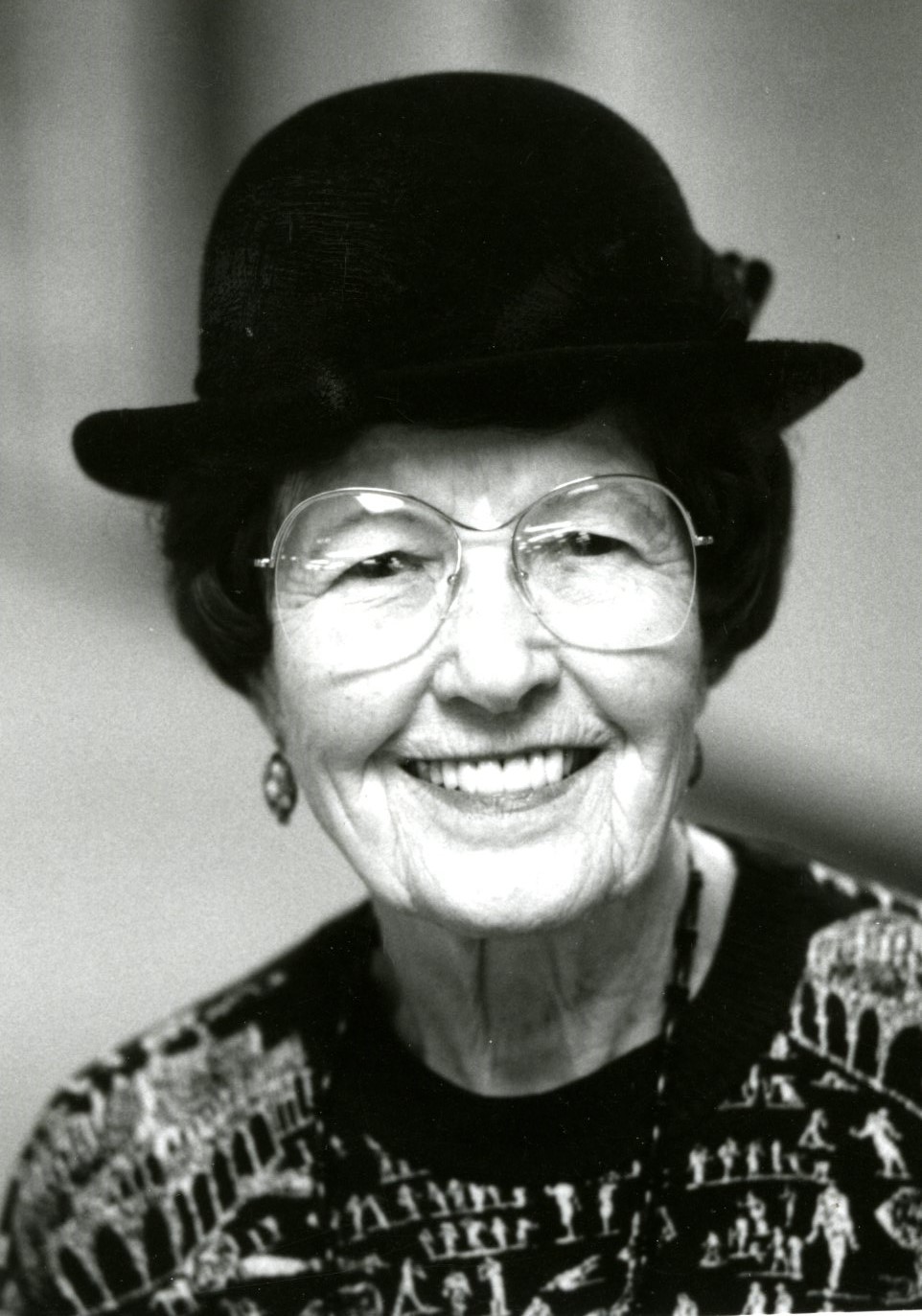 Elsie Mallinger was born near Sabin, Minnesota on March 2, 1903, the seventh of nine children. Her parents, John and Elizabeth Mallinger, moved to a farm near Ada, Minnesota when Elsie was young. Elsie entered country school at age four. Eventually she started teaching other students in the back of the class while the teacher continued teaching in the front. Elsie graduated high school at age sixteen and returned to her family’s farm for some time. She then attended Dakota Business College in Fargo, graduating in seven weeks. Elsie Mallinger was born near Sabin, Minnesota on March 2, 1903, the seventh of nine children. Her parents, John and Elizabeth Mallinger, moved to a farm near Ada, Minnesota when Elsie was young. Elsie entered country school at age four. Eventually she started teaching other students in the back of the class while the teacher continued teaching in the front. Elsie graduated high school at age sixteen and returned to her family’s farm for some time. She then attended Dakota Business College in Fargo, graduating in seven weeks.
|
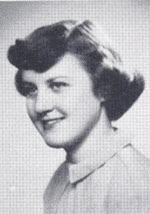 Margaret Signora Callsen discovered a love of learning in her time as a student at Concordia that she carried with her throughout the rest of her life and career. This love of learning grew in Callsen and she became determined to spread it to others through her own teaching at several universities. After her retirement she continued to encourage education by providing a generous donation to Concordia College to support junior faculty and undergraduate research. Margaret Signora Callsen discovered a love of learning in her time as a student at Concordia that she carried with her throughout the rest of her life and career. This love of learning grew in Callsen and she became determined to spread it to others through her own teaching at several universities. After her retirement she continued to encourage education by providing a generous donation to Concordia College to support junior faculty and undergraduate research.
|
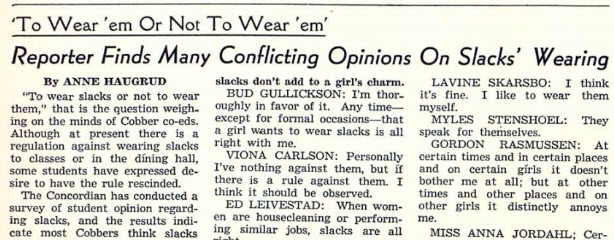 Double standards in the regulation of student conduct at Concordia College placed the liberties of women below those of men. Dress codes and smoking policies in particular explicitly treated female students differently than male students. A combination of student action as well as changing social views brought an end to these sexist differences in regulation over the course of the 1960s and 1970s. Double standards in the regulation of student conduct at Concordia College placed the liberties of women below those of men. Dress codes and smoking policies in particular explicitly treated female students differently than male students. A combination of student action as well as changing social views brought an end to these sexist differences in regulation over the course of the 1960s and 1970s.
|
 Darnell Carter attended Concordia College from 1971-1975 after growing up in Springfield, Ohio. He became involved in several organizations including Alpha Epsilon Sigma, the Concordian, and Harambee Weuse, the Black Student Union. Graduating from Concordia with degrees in history and English literature, Carter went on to study at Drake University Law School. He enjoyed a successful law career as an assistant prosecuting attorney for Clark County, Ohio from 1980-2008. Carter has also taught high school English, earned a master’s degree in history from Ohio State, and in 2018 received Concordia’s Alumni Achievement Award. Darnell Carter attended Concordia College from 1971-1975 after growing up in Springfield, Ohio. He became involved in several organizations including Alpha Epsilon Sigma, the Concordian, and Harambee Weuse, the Black Student Union. Graduating from Concordia with degrees in history and English literature, Carter went on to study at Drake University Law School. He enjoyed a successful law career as an assistant prosecuting attorney for Clark County, Ohio from 1980-2008. Carter has also taught high school English, earned a master’s degree in history from Ohio State, and in 2018 received Concordia’s Alumni Achievement Award.
|
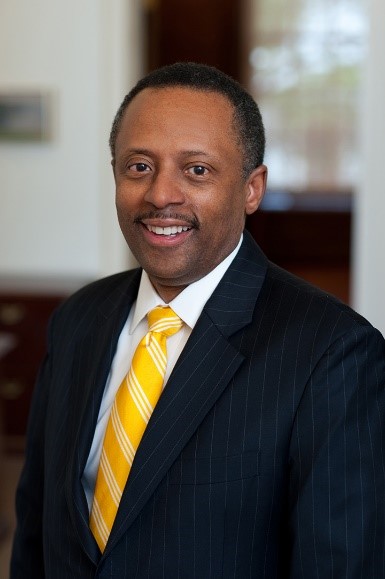 Born in Norfolk, Virginia, Earl Lewis came of age during the hard struggle for school integration in the South, and nationwide, that followed the landmark Brown v. Board of Education decisions (1954-1955). When Lewis studied at Concordia College between 1974 and 1978, the Civil Rights, Black Power, and Black Student Movements had already instigated momentous racial reform in the country’s colleges and universities. He participated in the Black Student Strike in the spring of 1976, a memorable marker in Concordia’s history as black student enrollments reached high tide before receding. Lewis’s academic achievements as an undergraduate anticipated a storied career as a scholar, administrator, innovator and entrepreneur, and leader in higher education. Serious and steady, yet affable and down-to-earth, Lewis embodies Concordia’s commitment to influence the world through studied preparation and dedicated service. Recipient of countless honors and awards, Lewis joined the college’s Board of Regents in 2008 and became chair in 2018. Born in Norfolk, Virginia, Earl Lewis came of age during the hard struggle for school integration in the South, and nationwide, that followed the landmark Brown v. Board of Education decisions (1954-1955). When Lewis studied at Concordia College between 1974 and 1978, the Civil Rights, Black Power, and Black Student Movements had already instigated momentous racial reform in the country’s colleges and universities. He participated in the Black Student Strike in the spring of 1976, a memorable marker in Concordia’s history as black student enrollments reached high tide before receding. Lewis’s academic achievements as an undergraduate anticipated a storied career as a scholar, administrator, innovator and entrepreneur, and leader in higher education. Serious and steady, yet affable and down-to-earth, Lewis embodies Concordia’s commitment to influence the world through studied preparation and dedicated service. Recipient of countless honors and awards, Lewis joined the college’s Board of Regents in 2008 and became chair in 2018.
|
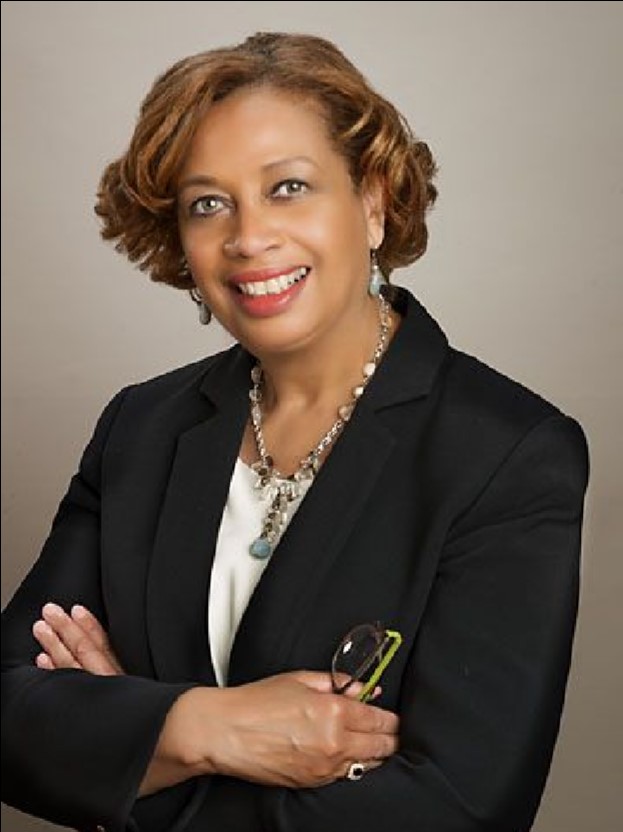 Born in La Porte, Indiana, offspring of a Lutheran household, Fay Holmes-Ferguson followed her faith tradition in attending Concordia College. As changes set in motion by the Civil Rights and Black Student Movements rippled through higher education, Holmes joined the first cohort of African American students on Concordia’s largely white campus. She graduated magna cum laude, going on to earn an M.B.A. degree from Indiana University. Holmes-Ferguson followed a successful career in advertising, eventually being named co-CEO at Burrell Communications Group, Chicago, Illinois. Ferguson joined Concordia’s Board of Regents in 2012. In 2016, Fay saw a need and felt compelled to create the Diversity Student Endowed Scholarship which she co-founded with Concordia alumnus Dr. Earl Lewis '78. The goal of the scholarship fund is twofuld: to encourage students from diverse backgrounds to attend a quality liberal arts college and to increase the diversity of experiences represented on Concordia's campus. A gifted executive and community leader, Ferguson’s core life motto of leading a purpose-driven life focused on helping others, exemplifies the spirit and mission of Concordia College. Born in La Porte, Indiana, offspring of a Lutheran household, Fay Holmes-Ferguson followed her faith tradition in attending Concordia College. As changes set in motion by the Civil Rights and Black Student Movements rippled through higher education, Holmes joined the first cohort of African American students on Concordia’s largely white campus. She graduated magna cum laude, going on to earn an M.B.A. degree from Indiana University. Holmes-Ferguson followed a successful career in advertising, eventually being named co-CEO at Burrell Communications Group, Chicago, Illinois. Ferguson joined Concordia’s Board of Regents in 2012. In 2016, Fay saw a need and felt compelled to create the Diversity Student Endowed Scholarship which she co-founded with Concordia alumnus Dr. Earl Lewis '78. The goal of the scholarship fund is twofuld: to encourage students from diverse backgrounds to attend a quality liberal arts college and to increase the diversity of experiences represented on Concordia's campus. A gifted executive and community leader, Ferguson’s core life motto of leading a purpose-driven life focused on helping others, exemplifies the spirit and mission of Concordia College.
|
 Emma Norbryhn was a linguistically gifted woman who instructed a variety of language courses at Concordia. During her lengthy teaching career she introduced new language courses and taught Norse, French, Latin, German, and Greek before retiring in 1948. At her retirement she held the title of longest term of service at the college. Today she is among a handful of Concordia faculty to reach the forty year mark.
Emma Norbryhn was a linguistically gifted woman who instructed a variety of language courses at Concordia. During her lengthy teaching career she introduced new language courses and taught Norse, French, Latin, German, and Greek before retiring in 1948. At her retirement she held the title of longest term of service at the college. Today she is among a handful of Concordia faculty to reach the forty year mark.




